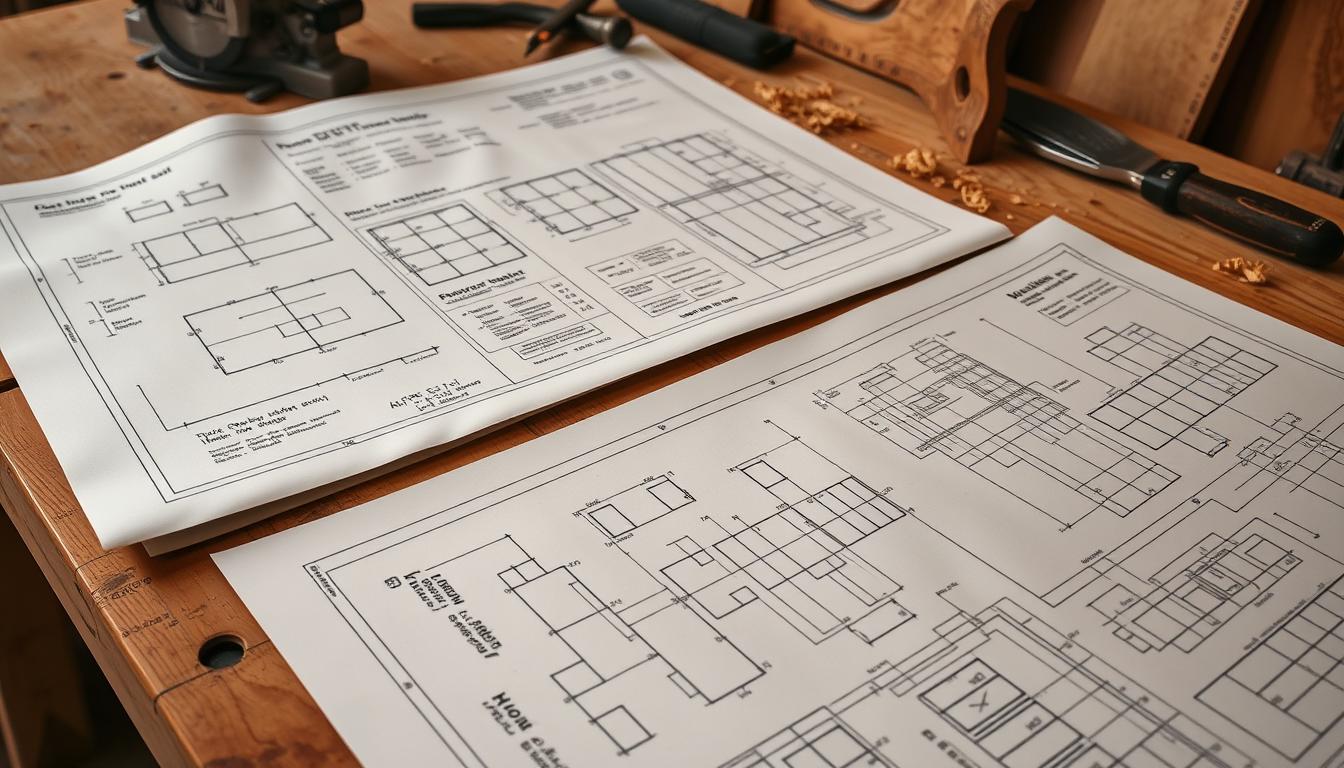In my Lumber Workshop, I’ve found a truth. The right guides make every project special. It’s not just making something; it’s bringing a dream to life.
Seeing well-made furniture or outdoor structures is exciting. It shows how imagination can become reality. I’ve looked at many free plans and ideas, finding designs that match my style and challenge my skills1.
Having a detailed blueprint makes me feel confident. It guides me through each step. Whether it’s a bookcase or a garden planter, I know it will be beautiful1.
Table of Contents
ToggleKey Takeaways
- Understanding the value of comprehensive woodworking plans for varied project complexity.
- Appreciating the range of plans available, from novices’ pieces to intricate designs for experienced woodworkers.
- Recognizing the role of detailed instructions and material lists in project success.
- Valuing the accessibility and affordability of online woodworking resources and design software.
- Embracing the beauty of custom woodworking as a way to enhance home decor and functionality.
- Recognizing the significance of detailed planning and technical drawings in custom woodworking.
>>Get 16,000 Woodworking Plans
Understanding the Importance of Woodworking Plans
If you love making beautiful wooden furniture, you need woodworking plans. These guides help you make everything from simple bookshelves to complex designs. They give you a clear way to create your projects.
What Are Woodworking Plans?
Woodworking plans are detailed blueprints for making furniture. They show you how to do each step, including measurements and materials needed. Many people find that using plans helps them make better projects and keeps things consistent3.
Benefits of Following Plans
Using woodworking plans helps you make accurate and reliable furniture. They guide you, reducing waste and mistakes. Even if you like to make changes, plans help keep your work consistent and high-quality3.
Common Materials Used
The type of wood you choose affects your project’s look, feel, and last. Pine is cheap and easy to shape4. Oak and walnut are durable and look great, making them perfect for fancy furniture4. Cedar is best for outdoor projects because it doesn’t get damaged by water4. Knowing about these woods helps you pick the right one for your project4.
| Wood Type | Characteristics | Common Uses |
|---|---|---|
| Pine | Affordable, easy to work with | Cabinetry, simple furniture |
| Oak | Durable, aesthetic | Flooring, high-end furniture |
| Walnut | Rich color, fine texture | Decorative pieces, luxury furniture |
| Cedar | Moisture resistant, durable | Outdoor furniture |
Woodworking plans are more than guides; they’re essential for keeping woodworking alive. By using detailed plans and learning about different woods, you can make your designs look professional.
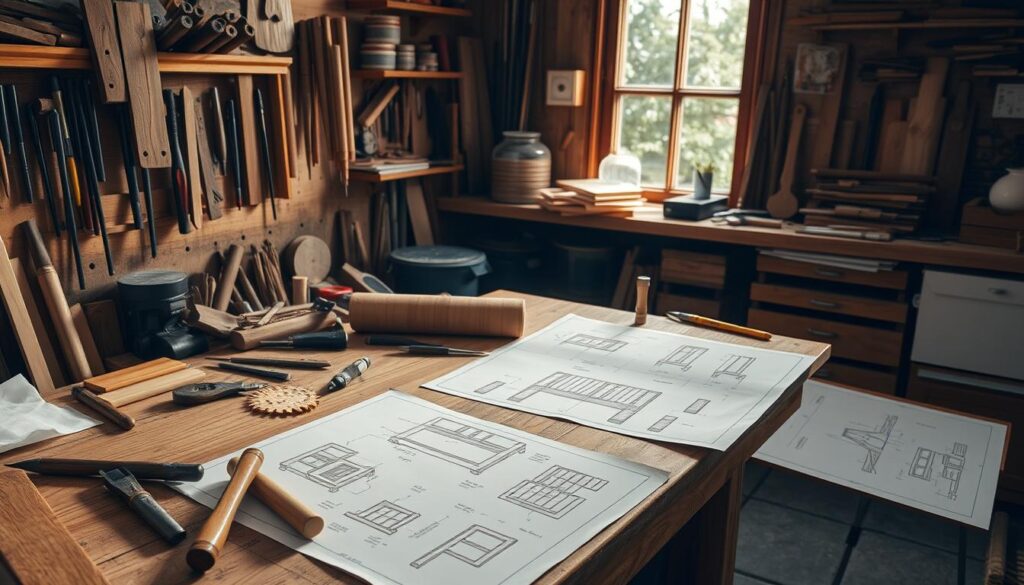
Types of Woodworking Blueprints
Exploring different woodworking blueprints can really boost your DIY skills. Whether you want to furnish your home or add unique touches outside, it’s all possible.
Furniture Designs
Woodworking blueprints offer a wide range of furniture designs. You can find plans for everything from tables and cabinets to chairs. These plans mix traditional techniques with modern styles. They come with detailed instructions and diagrams to make building fun and rewarding5.
Home Décor Projects
Woodworking blueprints aren’t just for furniture. They also include projects like floating shelves, elegant headboards, and bookshelves. These projects let you add a personal touch to your home. They make your living spaces unique and show off your skills5.
Outdoor Structures
Outdoor structures need special attention in woodworking blueprints. From garden beds to patio furniture, each plan is made to withstand the weather. They add beauty and function to your outdoor spaces. Whether you’re a beginner or an expert, there’s a plan for you5.
For more woodworking projects, check out woodcraft woodworking plans. They offer a wide range of projects for all skill levels. These resources will help you with every step of your woodworking journey5.

| Project Type | Blueprint Details | Skill Level |
|---|---|---|
| Furniture | Tables, cabinets, chairs with intricate designs and functional aspects. | Beginner to Advanced |
| Home Décor | Patterns for shelves, headboards, and bookcases to customize home aesthetics. | Intermediate |
| Outdoor Structures | Layouts for garden beds, outdoor seating, detailed construction steps included. | Advanced |
Essential Tools for Woodworking
Woodworking is both an art and a technique. The right tools are crucial for precision and efficiency. Whether you’re a beginner or a seasoned expert, understanding and gathering essential tools is key.
Hand Tools Every Woodworker Should Have
The foundation of any woodworking toolkit includes diverse hand tools. These tools allow for detailed, hands-on control over your projects. Quality chisels, from 1/8 inch to 1 inch, are indispensable for intricate work in Carpentry Designs6.
Essential layout tools for beginners include a 6-inch compass and a 12-inch combination square for accuracy. A 6-inch bevel gauge is also important for precise angles6. Marking tools like a sharp knife or a utility knife are great for precision lines. Back saws, 26- to 30-inch rip saws, and various planes enrich the toolkit extensively6.
Power Tools for Efficiency
In modern Wood Crafting Guides, power tools are celebrated for their ability to expedite tasks. Circular saws, ideally with blade diameters of 10” or 12”, make accurate cuts for larger projects7. An 18-volt cordless drill is a cornerstone tool, vital for countless tasks from drilling to driving screws7.
Safety Equipment and Gear
While immersing in the world of Carpentry Designs and Wood Crafting Guides, safeguarding personal safety is paramount. Essential safety gear includes goggles, dust masks, and gloves. These items protect against common hazards such as flying particles, wood dust, and potential impacts.
>>Get 16,000 Woodworking Plans

Following these guidelines and incorporating these fundamental tools and safety gear into your woodworking practice will enhance efficiency and safety. The journey into Wood Crafting Guides promises rewards and fulfillment, made richer with the proper tools at your disposal.
| Tool Type | Examples | Significance |
|---|---|---|
| Hand Tools | Chisels, Saws, Planes | Essential for detailed craftsmanship and finishing touches. |
| Power Tools | Circular Saws, Drills, Miter Saws | Enhance efficiency and allow for precision in complex tasks. |
| Safety Gear | Goggles, Dust Masks, Gloves | Protects against particles, wood dust, and other hazards. |
How to Read Woodworking Plans and Blueprints
Learning to read woodworking plans and blueprints is key for DIY wood projects and lumber workshop manuals. You’ll find symbols, measurements, and notations that are crucial for your project’s success. We’ll dive into these elements to help you complete your project successfully.
Symbols and Notations Explained
Woodworking plans use many symbols for instructions on joints, wood grain, and finishes. Knowing these symbols is essential for turning designs into real, beautiful pieces. Architectural scales, like 1/2”=1’, show the size relationship between your plan and the actual project8.
Line types are also important. Object lines show visible parts, hidden lines are short dashes for concealed parts, and center lines have alternating dashes for the central axis8
Dimensions and Measurements
Understanding dimension notations is crucial for accurate DIY wood projects. These measurements tell you how to cut and assemble wood for a perfect fit. Blueprints clearly show dimensions for precise cuts and placements.
For cabinetmakers, knowing cabinet codes like ‘W2430’ is vital8.
Understanding Project Complexity
Woodworking plans and blueprints categorize projects by complexity. This helps woodworkers choose tasks that fit their skills. These documents can be up to 50 pages long, covering title sheets, floor plans, elevations, and detailed drawings9.
Each view, elevation, and section offers a different perspective. Understanding these views is essential for seeing the project’s full scope8. This ensures woodworkers can anticipate challenges and choose projects that match their skill level.
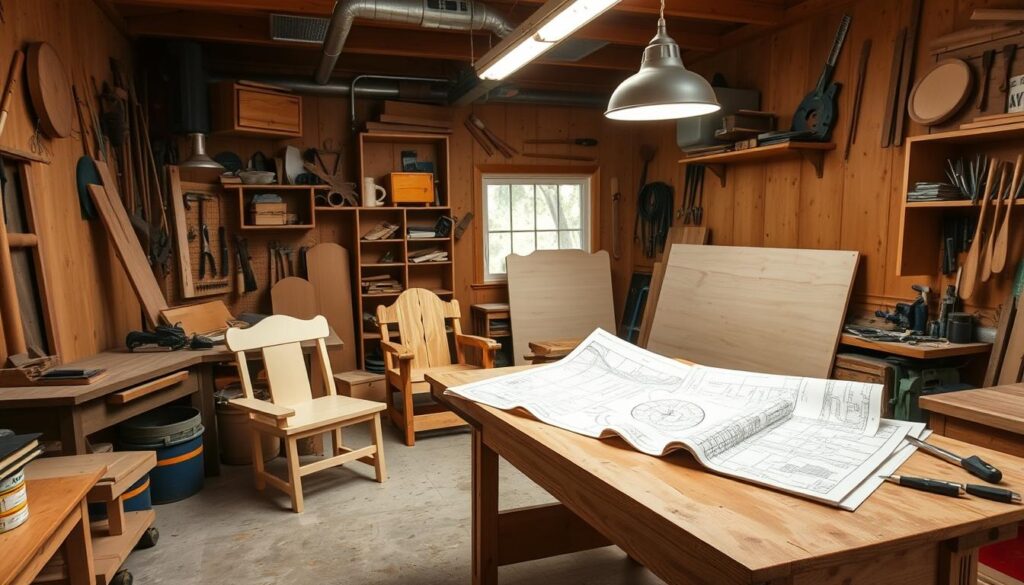
By understanding the details of woodworking plans and blueprints, you improve your skills in various woodworking and DIY projects. This knowledge is your foundation in carpentry and DIY craftsmanship.
Creating Your Own Custom Woodworking Plans
Starting to make your own woodworking plans is a fun journey for craft lovers. It mixes creativity, precision, and the right tools. Together, they make beautiful and useful pieces. DIY projects are getting more popular, and custom plans can turn wood into amazing projects.
Tips for Designing Your Plans
When designing your plans, think about what you want to make and how complex it will be. Knowing about different joints is key. For example, dovetail joints are great for drawers, and mortise and tenon are good for furniture frames. Each joint affects how the piece looks and how strong it is.
Using plans can help you get the project right by 72%10.
Software Tools for Planning
Using software like Crafty can make planning easier. It has features for simple sketches to advanced CAD designs. This helps with making everything from small decorations to big furniture pieces11.
With these tools, you can make sure all parts fit perfectly. Crafty even offers parts like PVC or aluminum to help11.
>>Get 16,000 Woodworking Plans
Testing Your Design
Before making your project, test it with prototypes or 3D models. This helps find any problems with how it works or looks. Crafty makes this easier by giving you exact parts lists and measurements11.
Listening to feedback is also important. Websites suggest watching tutorials and reading what others say to get better11.
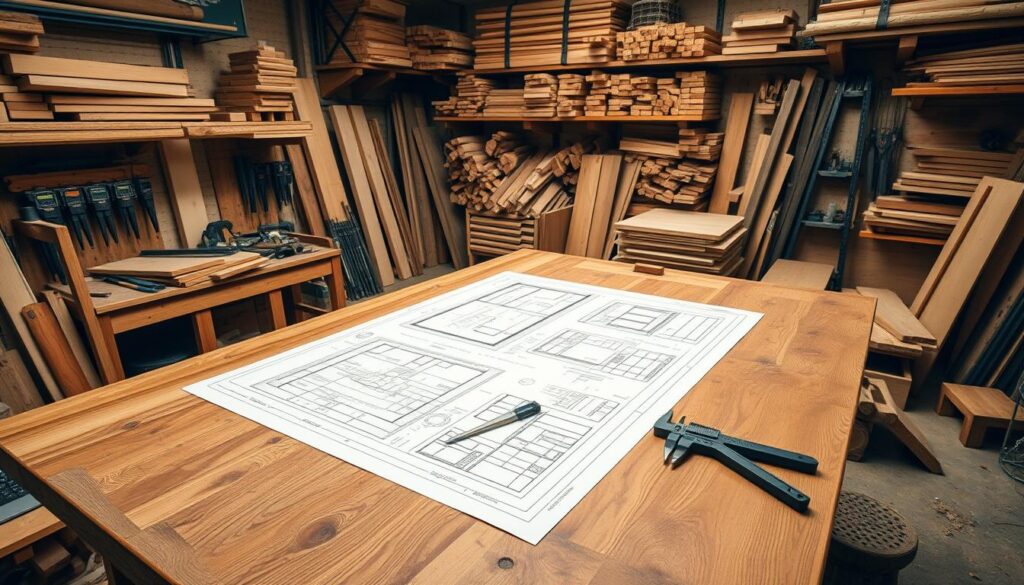
Going through these steps can really improve your woodworking skills. It turns your project idea into something real. Make your woodworking journey about being precise, creative, and efficient, thanks to good planning and testing.
Finding Reliable Sources for Plans and Blueprints
If you love woodworking, finding the best plans and blueprints is key. You need them for making furniture and detailed carpentry designs. Here’s how to find the right resources.
Websites and Online Resources
Books and Magazines
Woodworking books and magazines are full of great plans and tips. They help you learn and improve your skills. Woodsmith Plans even gives subscribers extra plans, like the Precision Crosscut Sled12.
Community Workshops and Classes
Community workshops and classes are the best way to learn. They give you real plans and expert advice. Plus, you get to meet other woodworkers and learn from them.
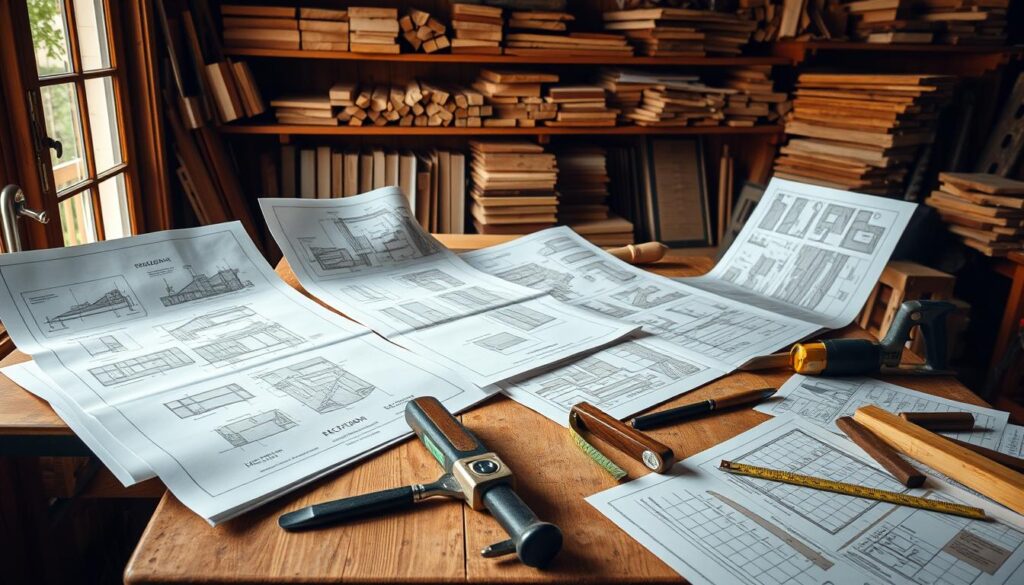
Whether you’re new or experienced, the right plans are crucial for success. Look at online sites, books, and workshops. They’ll help you start your woodworking journey strong.
Step-by-Step Guide to a Basic Woodworking Project
Starting DIY wood projects is exciting and rewarding. With the right plans, even beginners can make beautiful items. Follow a few key steps to confidently complete your project.
Preparing Your Workspace
First, set up your workspace for safety and efficiency. Make sure it’s well-ventilated, especially for finishes or adhesives. Also, have dust collection systems to keep the air clean.
A tidy workspace prevents accidents and makes it easier to find tools and materials. This helps keep your workflow smooth.
Gathering Materials and Tools
Before starting, collect all needed materials and tools. This step saves time and keeps you focused. For most projects, you’ll need saws, drills, and sanders.
Following the Blueprint
With your workspace ready and materials organized, follow your project’s blueprint. Wooden construction layouts guide you through each step, from cutting to assembly. For a simple wooden bench, you’ll need two boards and 18 screws to finish it in a couple of hours15.
Start with the base, then add mid-section parts, following the blueprint’s details. This ensures your project is strong and looks great.
In conclusion, each step in DIY wood projects is key to success. From setting up your workspace to following the plans, you’re well-prepared. Dive into your project with confidence and enjoy the rewarding outcome.
Troubleshooting Common Woodworking Issues
Exploring wood crafting guides and carpentry designs can be exciting. But, it’s important to know how to avoid common mistakes. These mistakes can affect the quality and look of your work.
Misaligned Cuts and Joints
Misaligned cuts and joints can ruin your project. This is especially true for complex designs that need precision. Using detailed plans can help avoid these problems and give your work a professional look.
Starting with accurate cuts saves time and materials16. It’s key to get it right from the beginning.
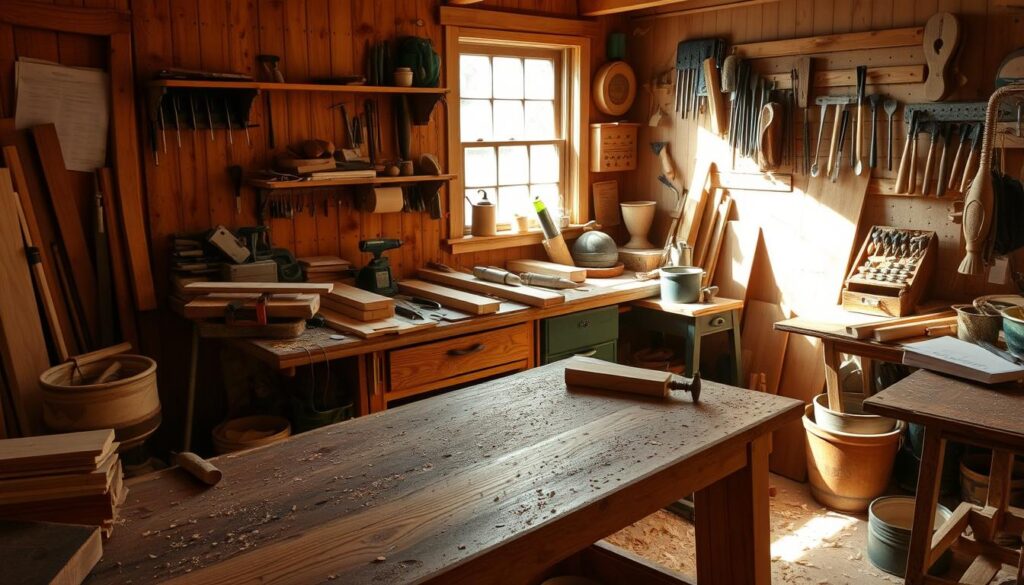
Tools like routers, table saws, and clamps are essential for precision16. Keeping these tools in good condition and using jigs can help you achieve perfect alignment and joints.
Material Shortages
Running out of materials can stop your project in its tracks. It’s wise to buy more than you think you’ll need. This way, you’re prepared for any unexpected issues or mistakes in cutting16.
Also, using tools like Bessemeter’s moisture meters can help prevent wood from warping. This ensures your project lasts longer16.
Inaccurate Measurements
Small mistakes in measurements can cause big problems. They can affect how well your project fits together, especially in detailed designs. It’s important to double-check your measurements before cutting.
Using high-quality measuring tools and being careful can help avoid these errors. Looking back at your projects can also help you learn from mistakes and improve your skills16.
Finishing Touches: Enhancing Your Wood Projects
When it comes to DIY wood projects, the final touches are key. They can make your wooden furniture look amazing. Whether it’s adding a protective stain or unique hardware, these steps are important. They ensure your project lasts and looks great.
Stains and Paints
Stains and paints do more than just color your wood. They protect it and highlight its natural beauty. For example, a semi-transparent stain on outdoor furniture protects it from the weather while showing off the wood’s grain17. Eco-friendly paints can also add color to your projects, like kitchen islands and bed frames, making them safe and stylish for inside use18.
Hardware and Accents
Hardware is not just for function; it adds character to your piece. From modern drawer pulls to rustic hinges, the right hardware can match your project’s style. Adding brass handles to a bar or a carved knob to a shoe rack not only makes it easier to use but also looks better18.
Caring for Your Finished Project
Keeping your DIY wood project in good shape is crucial. Regular cleaning and occasional touch-ups can keep it looking new. For outdoor items like picnic tables, a yearly coat of stain or varnish can keep it looking good and strong18. Also, checking for loose screws or worn-out parts on indoor furniture can prevent damage and keep it safe18.
In short, finishing your DIY wood projects right is more than just building them. It’s about adding the right touches that make them last, work well, and look great. By choosing the right stains, paints, and hardware, and taking care of them, you can make your wood projects last longer and stay beautiful.
Joining the Woodworking Community
Starting woodworking alone can be tough, but joining a community is priceless. I’ve found endless inspiration in Wood Crafting Guides and Lumber Workshop Manuals. The support from like-minded people has been a game-changer.
>>Get 16,000 Woodworking Plans
Online Forums and Social Media Groups
Apps like “Woodcraft” and “Woodworking for Mere Mortals” provide tutorials and plans19. These resources have taken my woodworking to new heights.
Local Clubs and Workshops
Nothing beats meeting woodworkers in person. Local clubs offer hands-on learning and real feedback. It’s a chance to learn from others and build lasting connections19.
Ted’s Woodworking’s plan library is vast, from simple to complex projects19. It’s a treasure trove for creativity.
Sharing Your Projects and Learnings
Woodworking is about personal growth and sharing with others. Every project I finish, whether it’s for home or outdoors, is a chance to share and learn1. By sharing, I help the community grow.
Looking back, I see that mistakes were just as valuable as successes19. In our community, we learn from every experience.
FAQ
What Are Woodworking Plans and How Do They Help in DIY Projects?
Woodworking plans are detailed guides that show how to make a project from start to finish. They help both newbies and pros by giving clear steps. This ensures your project goes smoothly and looks great.
What Types of Projects Can I Build With Woodworking Blueprints?
Woodworking blueprints let you make many things. You can build fancy furniture, home decor like shelves, or even outdoor stuff like garden beds. Each plan is made for different skill levels and tastes.
What Are the Essential Tools I Need for Woodworking?
Woodworkers need hand tools like chisels and saws for precise work. Power tools like drills make the job easier. Don’t forget safety gear like goggles and gloves.
How Do I Read and Understand Woodworking Plans?
Understanding woodworking plans means knowing symbols and notations. These show joints and wood grain. Knowing measurements is key for accurate cuts. Make sure the plan fits your skill level for success.
Can I Create My Own Custom Woodworking Plans and How?
Yes, you can make your own plans. Start by drawing your ideas. Then, use software to make your design better. Making prototypes helps find and fix problems before you start building.
Where Can I Find Reliable Woodworking Plans and Blueprints?
You can find good plans online or in books and magazines. Workshops and classes also offer plans and hands-on help.
What Are the Initial Steps to Starting a Basic Woodworking Project?
Starting a project means setting up a clean workspace. Gather all your tools and materials. Follow the plan carefully from start to finish for success.
How Do I Handle Common Woodworking Issues During My Project?
For common problems like misaligned cuts, have extra materials ready. Check your work often and double-check measurements before cutting.
What Finishing Touches Should I Consider for My Woodworking Project?
Choosing the right stain or paint enhances the wood. Selecting the right hardware adds style and function. Regular care keeps your project looking good for a long time.
How Can I Join the Woodworking Community and Share My Work?
Join online forums or local clubs to connect with woodworkers. Sharing your projects helps others learn and inspires you to try new things.
Source Links
- Free Woodworking Plans & Wood Project Ideas – https://learn.kregtool.com/learn/free-woodworking-plans/
- How To Design Furniture For Woodworking – https://woodandshop.com/learn-traditional-woodworking-with-hand-tools/getting-started-traditional-handtool-woodworking-step-5/
- Hand Tool Woodworking Instruction and Thoughts – https://www.renaissancewoodworker.com/woodworking-project-plans/
- Free Woodworking Plans: Your Guide to Mastering the Craft – https://www.linkedin.com/pulse/free-woodworking-plans-your-guide-mastering-thecraft-josef-etheridge-2caec
- Woodworking Plans – Downloadable Woodworking Guides – https://www.woodcraft.com/collections/woodworking-plans?srsltid=AfmBOooDwYyPsyWBwsAvT7PQV3wnrta6Wn-dkiyl1mwRShvKDQvKz3FE
- What tools are needed for a beginner woodworker – https://sawmillcreek.org/showthread.php?290442-What-tools-are-needed-for-a-beginner-woodworker&p=3108525
- 9 Most Essential Woodworking Tools For Beginners – American Rotary – https://www.americanrotary.com/blog/woodworking-tools-for-beginners/?srsltid=AfmBOoqsuIVImzbCgXJ2bKCht4e5LXwwvieRFEySI1sdZSpIim1UO-ox
- Understanding Blueprints: A Cheat Sheet for Cabinetmaking School Students – https://nats.ca/Home/NewsArticle/understanding-blueprints-a-cheat-sheet-for-cabinetmaking-school-students/
- How to Read Blueprints: A Complete Guide – https://mtcopeland.com/blog/how-to-read-blueprints-complete-guide/
- Plan Your Woodworking Project 101 – Bessemeter – https://www.bessemeter.com/blog/plan-your-woodworking-project-101/?srsltid=AfmBOoqx53uj23VaqymUrRKkSh-pwNKnmoH5Li2mVDMNO14RmJnepvIv
- Free Woodworking Design Software – https://www.craftyamigo.com/free-woodworking-design-software
- No title found – https://www.woodsmithplans.com/
- Free projects – https://www.craftsmanspace.com/free-projects
- Beginners Woodworking Guide: How to Start Woodworking – https://www.thecrucible.org/guides/woodworking/
- Easy Beginner Woodworking Projects – https://www.familyhandyman.com/list/surprisingly-simple-woodworking-projects-for-beginners/?srsltid=AfmBOooi3z9eqhGTwFd1jFfS0ul2rUMSrtzqZYRdYKvpLRl0OfxrOW77
- Plan Your Woodworking Project 101 – Bessemeter – https://www.bessemeter.com/blog/plan-your-woodworking-project-101/?srsltid=AfmBOoonfhKv-QDPWXd7MQIMoWW5sKjaK_ZIsma2RUPMrszS2jPvgxkp
- The JoineryPlans Website – 25,000+ Woodworking Plans – https://www.joineryplans.com/
- 30 Best Woodworking Projects – Free DIY Wood Projects & Plans – https://learn.kregtool.com/learn/woodworking-projects/
- A Beginner’s Guide to Using Free Woodworking Plans Effectively – https://www.linkedin.com/pulse/beginners-guide-using-free-woodworking-plans-art-chartier

